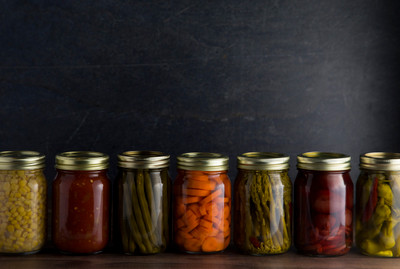Autumn Canning Ideas
Posted by The Wares Team on 24th Oct 2019
Following on from our earlier post about how the Americans can food, we thought
we’d look at some canning ideas that are just perfect for this time of year.
From canning in-season fruits and vegetables to stocking up on some hearty
meals or at least some base sauces for meals, canning has a lot to offer. Read
on to find out how you can build a larder full of home-canned loveliness to see
you through those long, cold winter days.
Stocking Up On Ball Jars
The first thing to think about is the canning jars that you’ll need.
Traditional jam jars are fine for jams, jellies, chutneys and pickles, but for
water-processed canning, you need to source a supply of proper canning jars.
Ball jars, also known as Mason jars, are the right kind of jar to use.
They’re thicker than standard jam jars and they have a two-part lid which forms
an airtight seal when processed under pressure in a pressure canner or cooker.
Ball is an American brand and in the UK we’re perhaps more familiar with Kilner
jars which work in the same way. Provided that your canning jars have the
two-part lid, it doesn’t matter whether you choose Ball jars or Kilner jars -
and as luck would have it, at Wares, we stock a huge range from both brands!
How To Fill Those Ball Jars
If you’re new to home canning, it might be sensible to start by canning some
simple vegetables, such as green beans. It makes sense to try to can as many
beans as possible in one go in order to make the most of your time and effort,
so try to wait until you have a large quantity of beans to harvest. Wash the
beans and then top and tail them and remove the strings from either side of
each bean. Then roughly chop the beans and pack them into warmed, sterilised
jars. Larger jars are better for this type of canning.
Leave an inch at the top of the jar. Add around 1 teaspoon of salt to each jar
and then pour boiling water over the beans, again leaving a gap of an inch at
the top. Make sure that there are no air pockets trapped in any of the jars and
jiggle the beans if necessary to remove any air. Once you’re happy that the
beans are packed in tightly, fix the two-part lid in place.
Process in your pressure cooker or pressure canner for the time specified in
the instruction manual - typically, this would be about 20-25 minutes for green
beans. After the jars have been processed, remove from the pressure cooker or
canner and allow to cool. Always test the lids for a good seal before storing
in a cool, dry space.
Once you have got the hang of canning green beans, you can move on to can any
other seasonal vegetables that you might have grown in your veg patch or
allotment. Carrots and peas make a great canning combination, whilst sweetcorn,
peppers, chillies, tomatoes, pumpkins and squashes can all be canned
effectively for use throughout the year. Where some vegetables don’t respond
well to freezing, losing their consistency and texture, with canning, you can
keep that "fresh as the day it was picked" taste and texture.
Fruit Treats For Canning
Autumn is apple picking time and even a modestly-sized tree can produce a huge
quantity of apples each year. If you don’t want to fill your freezer with
chopped apples and you don’t feel confident storing the apples in a cool, dark
place through the autumn and winter, why not try filling a few canning jars
with your apple crop?
Simply peel and core your apples and then place them in a large pan with an
inch of water and heat on a high setting for around 15 minutes, until the
apples are soft and ready to be pulped in a food processor. You may need to
stir the apples occasionally during this time, to prevent sticking.
Once they are soft, leave them to cool for 5 minutes and then whizz them
through the food processor or blender to make a smooth sauce. Pour into clean,
sterilised Ball jars, then wipe the rims and seal with the two-part lids. Then
place in your pressure canner and fill the canner with water, before processing
according to your canner’s instruction manual.
You can also can bananas and pumpkins in this way, for use in cakes or as a
pour-over sauce for desserts.
Fig trees are another common garden tree that produces a huge crop and it can
be difficult to know what to do with all those figs. Since figs are popular at
Christmas, why not make some unique homemade gifts by canning some figs in
syrup, to give away to friends and family during the festive season. Blanch
your figs in boiling water, then pack them into canning jars and cover with a
sugar and water syrup, before sealing and processing in your pressure canner.

